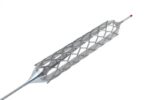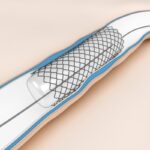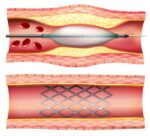Original title: Predicting Outcome in the COURAGE Trial. Coronary Anatomy Versus Ischemia. Reference: G. B. John Mancini et al. J Am Coll Cardiol Intv 2013, Article in press. Anatomical risk, ischemic amount or a combination of both, are often factors taken into account for estimating the prognosis or choose a treatment strategy. The COURAGE study (Clinical Outcomes Utilizing<a href="https://solaci.org/en/2014/01/24/ischemic-versus-anatomical-risk-is-anyone-better-to-help-us-decide-therapeutically/" title="Read more" >...</a>
Everolimus-eluting stent and DEB in restenosis for BMS. Good results of both with some expected differences.
Original title: A Randomized Comparison of Drug-Eluting Balloon Versus Everolimus-Eluting Stent in Patients With Bare-Metal Stent In-Stent Restenosis: The RIBS V Clinical Trial. Reference: Fernando Alfonso et al. J Am Coll Cardiol. 2014; Epub ahead of print. Drug-eluting stents (DES) have proven to be superior in terms of restenosis than bare metal stents (BMS). BMS, however due<a href="https://solaci.org/en/2014/01/22/everolimus-eluting-stent-and-deb-in-restenosis-for-bms-good-results-of-both-with-some-expected-differences/" title="Read more" >...</a>
Longer follow-up registry of angioplasty in left main coronary artery. Significant differences according to the diseased segment.
Original title: The DELTA Registry (Drug-Eluting Stent for Left Main Coronary Artery Disease): A Multicenter registry Evaluating Percutaneous Coronary Intervention Versus Coronary Artery Bypass Grafting for left Main Treatment Reference: Naganuma T, et al. J Am Coll Cardiol Intv 2013;6:1242–9 Angioplasty of the unprotected left coronary trunk has increased significantly in recent years showing good results. Currently the<a href="https://solaci.org/en/2014/01/20/longer-follow-up-registry-of-angioplasty-in-left-main-coronary-artery-significant-differences-according-to-the-diseased-segment/" title="Read more" >...</a>
Everolimus -eluting stent to 3 years, most security was the key difference.
Original title: Everolimus-eluting stents in patients undergoing percutaneous coronary Intervention: Final 3-year results of the Clinical Evaluation of the XIENCE V Everolimus Eluting Coronary Stent System in the Treatment of Subjects With de Novo Native Coronary Artery Lesions trial. Reference: Sorin J. Brener et al. Am Heart J 2013;0:1-8. The XIENCE stent (Abbott Vascular, Santa Clara, CA) is<a href="https://solaci.org/en/2013/12/10/everolimus-eluting-stent-to-3-years-most-security-was-the-key-difference/" title="Read more" >...</a>
Primary angioplasty with 2nd generation drug-eluting stents
Original title: Stent thrombosis with second-generation drug-eluting stents compared with bare-metal stents: Network meta-analysis of primary percutaneous coronary intervention trials in ST-segment–elevation myocardial infarction. Reference: Circ Cardiovasc Interv. 2013; Epub ahead of print. To compare the safety and efficacy of 2nd generation drug-eluting stents (DES) versus bare metal stents (BMS) in the context of primary angioplasty was conducted<a href="https://solaci.org/en/2013/12/10/primary-angioplasty-with-2nd-generation-drug-eluting-stents/" title="Read more" >...</a>
Angioplasty or medical therapy in patients with documented ischemia
Original title: Percutaneous coronary intervention outcomes in patients with stable obstructive coronary artery disease and myocardial ischemia: A collaborative meta-analysis of contemporary randomized clinical trials. Reference: Stergiopoulos K el al. JAMA Intern Med 2013; DOI:10.1001/jamainternmed.2013 The amount in ischemic patients with stable coronary heart disease is associated with poor prognosis. However, it is unclear whether revascularization to reduce<a href="https://solaci.org/en/2013/12/06/angioplasty-or-medical-therapy-in-patients-with-documented-ischemia/" title="Read more" >...</a>
Drug eluting balloon followed BMS versus DES in de novo lesions
Original title: Elutax paclitaxel-eluting balloon followed by bare-metal stent compared with Xience V drug-eluting stent in the treatment of de novo coronary stenosis: A randomized trial. Reference: Francesco Liistro et al. Am Heart J 2013;166:920-6. Recently, drug eluting balloons (DEB) have emerged as a potential alternative to drug-eluting stents (DES). Paclitaxel is an appropriate drug for DEBs given<a href="https://solaci.org/en/2013/12/03/drug-eluting-balloon-followed-bms-versus-des-in-de-novo-lesions/" title="Read more" >...</a>
Amputation, one of worse prognostic variables
Original title: Lower Extremity Amputation: Factors Associated With Mortality or Contralateral Amputation Reference: Samir K. Shah, et; al. Vascular and Endovascular Surgery 2013:47 (8):608-613. Peripheral vascular disease is associated with trophic injuries with tissue lose, often leading to amputation, of which about 50 % were major amputations. 454 amputations in 391 patients were analyzed, 63 were contralateral. Most<a href="https://solaci.org/en/2013/11/29/amputation-one-of-worse-prognostic-variables/" title="Read more" >...</a>
Similar results of drug-eluting stents with biodegradable polymer versus permanent
Original title: Biodegradable Polymer Biolimus-Eluting Stent Versus Durable Polymer Everolimus-Eluting StentA Randomized, Controlled, Noninferiority Trial.NEXT trial. Reference: Masahiro Natsuaki et al. J Am CollCardiol 2013;62:181–90. Drug-eluting stents with biodegradable polymer were designed to counteract the long-term adverse effects on the vascular wall of permanent polymer. This prospective, multicenter, randomized, non-inferiority design study, compared the biolimus eluting stent with<a href="https://solaci.org/en/2013/11/15/similar-results-of-drug-eluting-stents-with-biodegradable-polymer-versus-permanent/" title="Read more" >...</a>
The largest series of post TAVI coronary occlusion published
Original title: Predictive Factors, Management and Clinical Outcomes of Coronary obstruction Following Transcatheter Aortic Valve Implantation Insight From a Large Multicenter Registry Reference: Henrique B. Ribeiro, et; al. J Am Coll Cardiology 2013;62:1552-62 Percutaneous implantation of the aortic valve is a valid strategy in high-risk surgical patients. One of the possible complications of this procedure is the occlusion<a href="https://solaci.org/en/2013/10/29/the-largest-series-of-post-tavi-coronary-occlusion-published/" title="Read more" >...</a>









